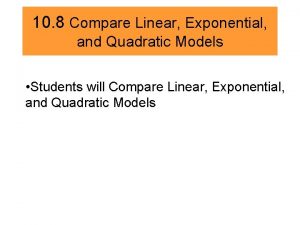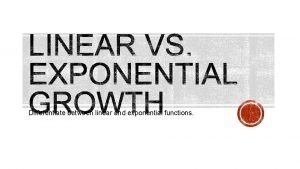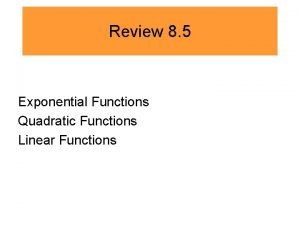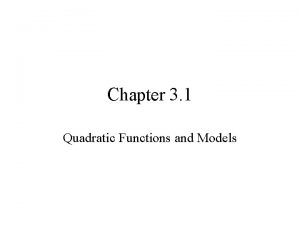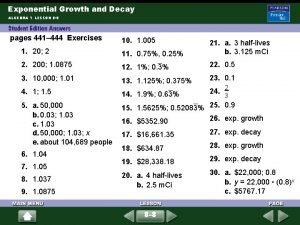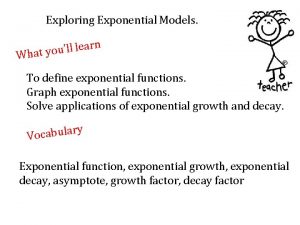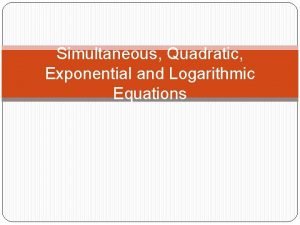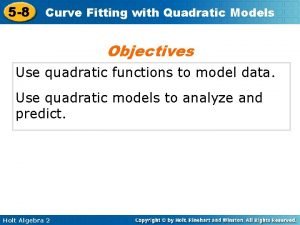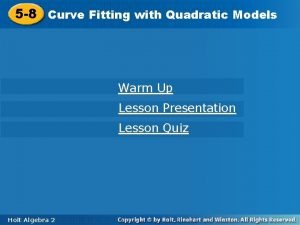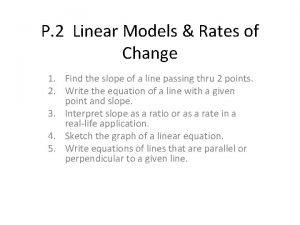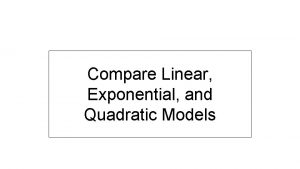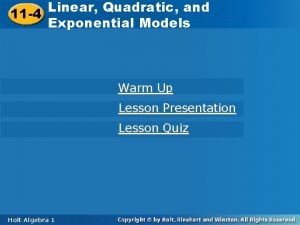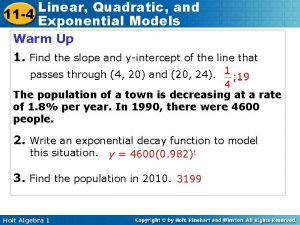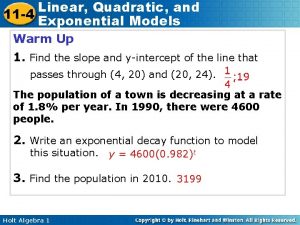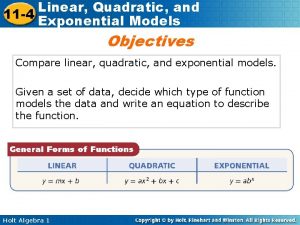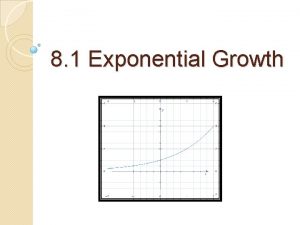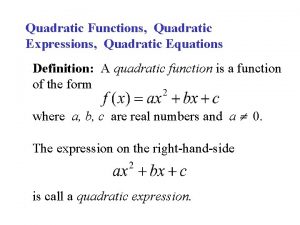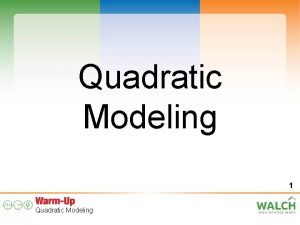10 8 Compare Linear Exponential and Quadratic Models



















- Slides: 19

10. 8 Compare Linear, Exponential, and Quadratic Models Warm Up Lesson Presentation

10. 8 Warm-Up 1. Graph y = 3 x. ANSWER 2. Tell whether the ordered pairs (0, 0), (1, 2), (2, 4), and (3, 6) represent a linear function. ANSWER yes 3. For y = x 2 – 3 x – 5, find corresponding y-values for the x-values – 2, 1, and 3. ANSWER 5, – 7, – 5

10. 8 Example 1 Use a graph to tell whether the ordered pairs represent a linear function, an exponential function, or a quadratic function. 1 a. – 4, 32 , 1 – 2, 8 SOLUTION a. Exponential function , 0, 1 2 , 2, 2 , 4, 8

10. 8 Example 1 b. – 4, 1 , – 2, 2 b. Linear function , 0, 3 , 2, 4 , 4, 5

10. 8 Example 1 c. – 4, 5 , – 2, 2 c. Quadratic function , 0, 1 , 2, 2 , 4, 5

10. 8 Guided Practice 1. Tell whether the ordered pairs represent a linear function, an exponential function, or a quadratic function: (0, – 1. 5), (1, – 0. 5), (2, 2. 5), (3, 7. 5). ANSWER quadratic function

10. 8 Example 2 Use differences or ratios to tell whether the table of values represents a linear function, an exponential function, or a quadratic function. a. x y – 2 – 6 – 1 – 6 First differences: 0 Second differences: 2 0 – 4 2 1 0 4 2 2 6 6 2 ANSWER The table of values represents a quadratic function .

10. 8 Example 2 b. x – 2 – 1 0 1 2 y – 2 1 4 7 10 Differences: 3 3 ANSWER The table of values represents a linear function.

10. 8 Guided Practice 2. Tell whether the table of values represents a linear function, an exponential function, or a quadratic function. x – 2 – 1 0 1 y 0. 08 0. 4 2 10 ANSWER exponential function

10. 8 Example 3 Tell whether the table of values represents a linear function, an exponential function, or a quadratic function. Then write an equation for the function. SOLUTION Determine which type of function the table of values represents.

10. 8 Example 3 The table of values represents a quadratic function because the second differences are equal.

10. 8 Example 3 STEP 2 Write an equation for the quadratic function. The equation has the form y = ax 2. Find the value of a by using the coordinates of a point that lies on the graph, such as (1, 0. 5). y = ax 2 Write equation for quadratic function. 0. 5 = a(1)2 Substitute 1 for x and 0. 5 for y. 0. 5 = a Solve for a. ANSWER The equation is y = 0. 5 x 2.

10. 8 Example 3 CHECK Plot the ordered pairs from the table. Then graph y = 0. 5 x 2 to see that the graph passes through the plotted points.

10. 8 Guided Practice Tell whether the table of values represents a linear function, an exponential function, or a quadratic function. Then write an equation for the function. 3. ANSWER linear function, y = 2 x 1 4. ANSWER quadratic function, y = 2 x 2

10. 8 Example 5 CYCLING The table shows the breathing rates y (in liters of air per minute) of a cyclist traveling at different speeds x (in miles per hour). Tell whether the data can be modeled by a linear function, an exponential function, or a quadratic function. Then write an equation for the function.

10. 8 Example 5 SOLUTION STEP 1 Graph the data. The graph has a slight curve. So, a linear function does not appear to model the data.

10. 8 Example 5 STEP 2 Decide which function models the data. In the 63. 3 57. 1 table below, notice that 1. 11, 57. 1 51. 4 70. 3 1. 11, 78. 0 1. 11, and 86. 6 1. 11. 63. 3 70. 3 78. 0 So, the ratios are all approximately equal. An exponential function models the data.

10. 8 Example 5 STEP 3 Write an equation for the exponential function. The breathing rate increases by a factor of 1. 11 liters per minute, so b = 1. 11. Find the value of a by using one of the data pairs, such as (20, 51. 4). y = abx 51. 4 = a(1. 11)20 51. 4 =a (1. 11)20 6. 38 ANSWER a Write equation for exponential function. Substitute 1. 11 for b, 20 for x, and 51. 4 for y. Solve for a. Use a calculator. The equation is y = 6. 38(1. 11)x.

10. 8 Guided Practice 5. In Example 4, suppose the cyclist is traveling at 15 miles per hour. Find the breathing rate of the cyclist at this speed. ANSWER about 30. 5 liters of air per minute
 Linear quadratic exponential examples
Linear quadratic exponential examples Linear vs quadratic vs exponential
Linear vs quadratic vs exponential Difference between exponential and linear
Difference between exponential and linear Linear exponential quadratic logarithmic
Linear exponential quadratic logarithmic Define geocentric and heliocentric
Define geocentric and heliocentric Logarithmic curve fitting
Logarithmic curve fitting Difference between modal and semi modal verbs
Difference between modal and semi modal verbs How to find domain of a parabola
How to find domain of a parabola Linear quadratic function
Linear quadratic function Exponential growth and decay algebra 1
Exponential growth and decay algebra 1 Exponential decay model
Exponential decay model 7-1 practice exploring exponential models form g
7-1 practice exploring exponential models form g 7-1 exploring exponential models
7-1 exploring exponential models Exponential decay formula
Exponential decay formula Quadratic exponential equations
Quadratic exponential equations Graphing linear and exponential functions
Graphing linear and exponential functions Quadratic curve fitting
Quadratic curve fitting Curve fitting with quadratic models
Curve fitting with quadratic models Linear communication model
Linear communication model Linear models and rates of change
Linear models and rates of change
